Rockfish are caught in the Pacific ocean and are found in large numbers from southern California to northern Alaska. Personally, I have fished for rockfish in Sitka Alaska and Juneau Alaska on bottom fishing trips when running charter boats. There are 130 different species of rockfish. Rockfish are frequently caught when fishing for halibut, ling cod, and salmon.
In Alaska, these fish are placed into two categories, pelagic and non-pelagic rockfish. Common Pelagic rockfish are dusky rockfish and black rockfish. Pelagic rockfish are often caught in water ranging from 40-200 feet deep and swim in large schools around rock-piles and reef structures.
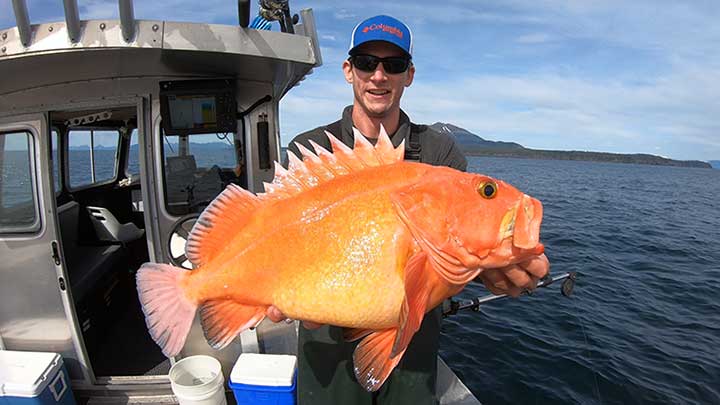
Non-pelagic rockfish are typically found in deep water from 100-600 feet deep near any bottom structure. These fish are less common and include the quillback rockfish, yelloweye rockfish, and shortraker rockfish. Most pelagic rockfish that get caught are 7-30 years old compared to non-pelagic rockfish that are typically 15-75 years old but can live to be over 190 years old.
Rockfish are relatively easy to target and are a great eating fish. It is important to locate rockfish with a fish finder before dropping baits. This is especially true when anchoring in one spot. If you are drifting you can locate fish while you drift. Depending on the current rockfish will move around rock piles and humps. Fish can be piled up on the hump, down-current, up-current, or on a certain depth on a ledge. It is important to move around initially and find the fish!
Here Are the Best Rockfish Fishing Lures, Baits, and Rigs
1. Mooching Rig for Rockfish
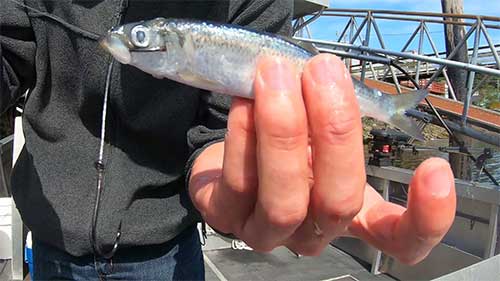
A mooching rig is typically baited with herring. This is a common technique used for salmon fishing but also works the best for rockfish when fishing in under 200 feet of water. Rockfish can be caught on almost any structure you find in the water. Typically I look for a shallow peak in about 60 feet of water with deeper water around the peak. While drifting over the peak I look for rockfish on the fish finder on the bottom or suspended above the bottom. This tells me what depth to target the rockfish when mooching. Typically the schools of rockfish are suspended 10 to 40 feet off the bottom. The large non-pelagic rockfish are usually right on the bottom in water deeper than 100 feet. In the video below I show how to hook up the bait and how to mooch.
Mooching Leader
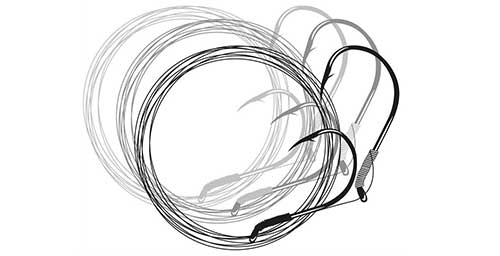
This is a pre-made 40-pound leader with a 4/0 and a 5/0 hook. The length is about 6-feet. Each hook is tied to the leader with snell knots. The herring is hooked on using the front hook. The hook is placed through the membrane on the bottom jaw of the fish. It then comes around to the other side of the fish and is placed through the center of the head securing it in some meat. The back hook can hang free or be placed in the top of the back behind the dorsal fin. Having the trailing hooks helps with the bite to catch ratio. When you get a bite while mooching you need to reel up any slack quickly.
Mooching Slider
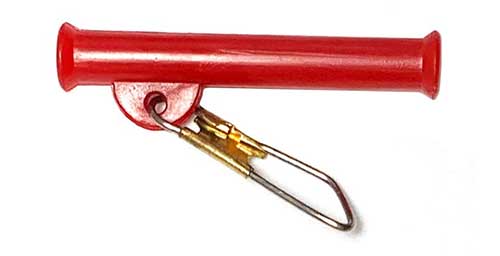
This red 1-1/2 inch slider is where the lead weight is attached. This slider is placed above the bead swivel on the mainline. Sometimes this slider is black but red is the most common color. A gum pucky can be placed in front of the slider but this is optional. The long side of the slider goes toward the bead swivel on the rig. The swivel makes it so mooching weights can be quickly put on and off the rig. When traveling from location to location the weight usually stays on the rig and is wrapped around the reel of the fishing pole.
Six Bead Swivel

A six-bead swivel is the most common type of swivel used on a mooching rig. Any quality swivel could be used. I have used a ball-bearing barrel swivel and it works great as well. The swivel helps minimize the line from getting twisted as the bait spins. The mainline is tied to one end of the swivel and the leader is tied to the other end of the swivel.
Round Ball Sinker Weight
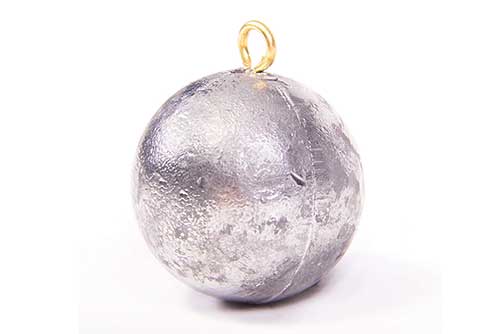
A lead weight of 6 or 8 ounces is used when mooching for rockfish. Banana weights were common for years but most people are using round weights these days. The swivel on the slider rig is placed through the metal ring on the weight. This is a quick way to add and change weights throughout the day. In a current, the 6-ounce weight is best as it is easier to reel up. In a strong current 8-ounces is often needed to reach the bottom.
2. Circle Hook Bottom Rockfish Rig
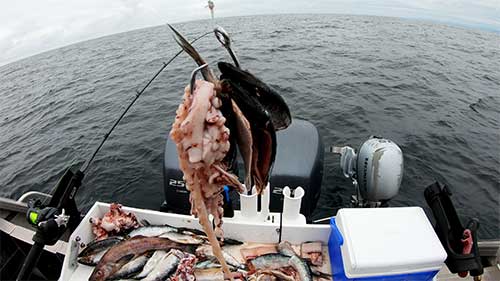
The best bait to catch large pelagic rockfish is lots of fresh bait on a circle hook. This is how we fish for halibut but sometimes we have to move and do not fish certain areas because we would catch too many rockfish. This rig also lets you fish deep and in strong currents. In the video below I show exactly how to make this rig. Typical bait includes herring, pollock, pink salmon, squid, and octopus. When targeting rockfish you want the bait to be very close to the bottom. If you are targeting halibut and lingcod the bait should be about 15-feet off the bottom which should reduce the number of non-pelagic rockfish that will be caught. Rockfish show up good on the fish finder right on the bottom. If the bottom is varying in-depth and not flat chances are there will be rockfish in that spot.
Circle Hook
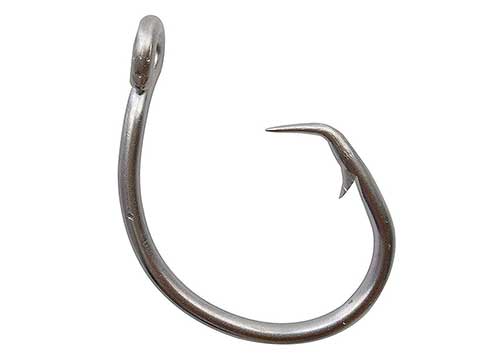
A size 14 hook is perfect for rockfish. Typically I use a size 16 hook because I am mostly halibut fishing and then also catch rockfish. I tie a perfection loop and put the loop through the eye of the hook. This makes the hook tip role into the fish’s lip. I explain and show how to make the rig in the video below. These hooks do not rust and stay pretty sharp. If you use the same hook for a month straight I would recommend sharpening the hook. This rig is fished best fished with a 30-50 class conventional fishing reels.
Round Lead Cannonball Weight

This weight comes in sizes from 1 ounce to 4 pounds. These round weights work perfectly for bottom fishing. I typically use a two-pound weight. A one-pound weight typically works in under 200 feet of water. If there is a really strong current a three-pound weight is needed to keep the rig on the bottom. If anglers have a hard time reeling up heavy lead weights an electric fishing reel can be used.
Green Braided Twine Leader
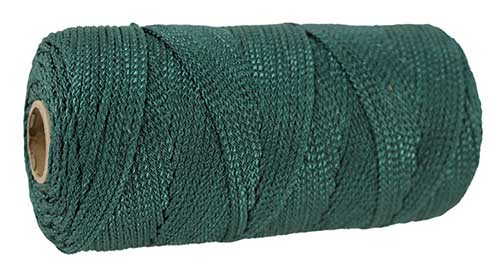
Size 36 braided nylon twine works great for making leaders. This is often referred to as ganyen line. This spool comes with 541 feet of rope. In the video below, I show how to tie the knots with this twine. The exact line I was using was in the video was Ashaway tuna leader, green in color. This tuna line had a solid braided nylon core with a strength of 150 pounds. It comes in 1 pound spools for around $50.
Barrel Swivels
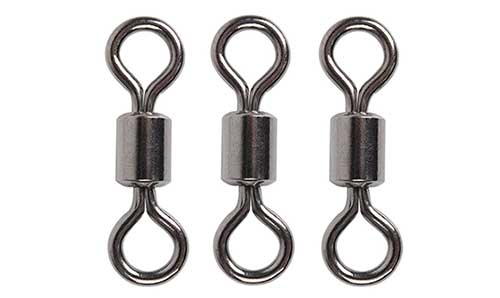
A size 2/0 barrel swivel works for two of the swivels of the custom bottom rig. Any large barrel swivel would work. One of these swivels is tied between the mainline and the twine. The other swivel is tied to the monofilament line and is attached to the snap swivel on the end of the twine. This makes it so the bait can be quickly changed out. Typically I have several of the bottom leader hooks baited up and ready to replace the old bait when a fish is caught or the bait is checked.
Snap Swivels
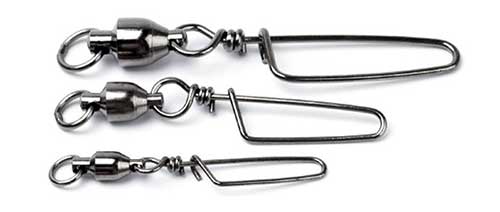
Size 6/0 snap swivels are used to attach the lead weights and to attach the bottom leader to the twine. Any large snap swivels would work for this. Always make sure the swivels are closed before dropping the bait.
Heavy Monofilament Leader Line
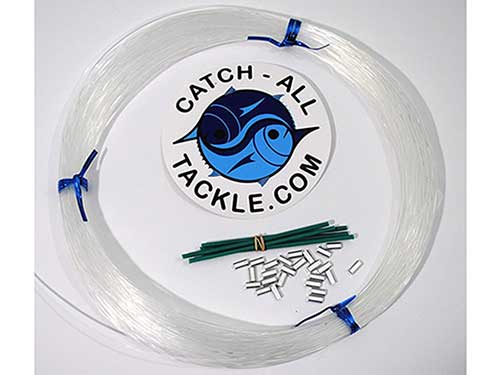
A clear 100-pound leader line is used for the bottom leader. Rockfish and halibut are not leader shy and many people including commercial fishermen just tie the hook directly to ganyen or twine. I like to have a clear leader. I have had the 100-pound line break a few times when leadering large halibut that I was trying to release.
In the video above I show how to tie the best bottom rigs for big rockfish and halibut.
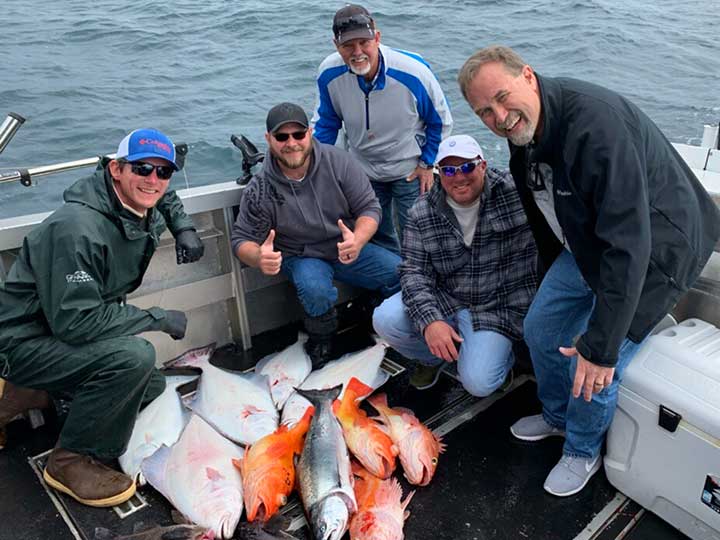
3. Chicken Rig for Rockfish
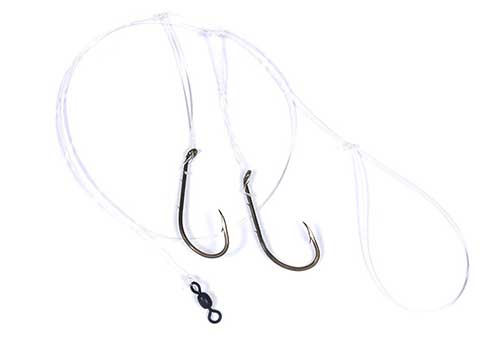
The most common way to bottom fish all over the world is to use a chicken rig. This rig has a weight on the bottom and two hooks that are tied about two feet apart using dropper loop knots. The mainline is attached to the rig with a barrel swivel. The weight on the bottom can be tied to or wrapped around a perfection loot knot. In the video below I show how to tie these knots. The hooks are baited with dead or live bait depending on what is available.
Rockfish typically eat herring, sand lace, other rockfish, and crustaceans. Cut herring is a great bait to use for all types of rockfish. If the baitfish in the area are sardines, anchovy, or smelt that would be a good option as well. Cut the bait into one or two-inch pieces and put a chunk on each hook. When targeting bigger fish put the whole baitfish on the hook. Rockfish typically bite as soon as the bait is on the bottom. So be ready to set the hook and check the bait after getting a bite, especially if you do not get a bite for a while.
Circle Hook for Bottom Rig
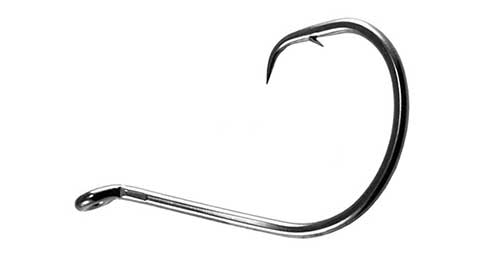
A circle hook works well because it is hard to feel the bite of small rockfish to properly set the hook because of the large weights typically needed. With circle hooks, the fisherman does not need to set the hook. Size 5/0 is good for small rockfish and 8/0 is good for large rockfish.
Seguar Fluorocarbon Leader Line
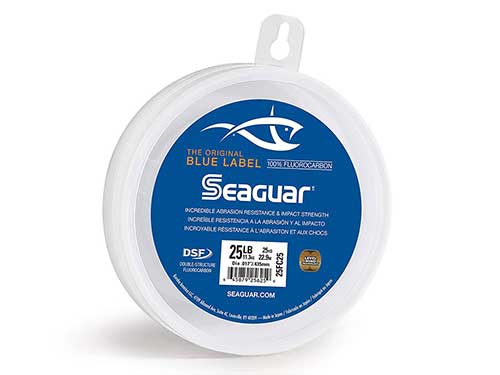
50-pound Seaguar leader line for the leader material. In reality, expensive fluorocarbon is not needed for rockfish. Any 50-pound fishing line that is available will work. If you are just going to catch rockfish even a 20-pound line would work. Eventually, a big fish will bite though so I like using a 50-pound line for bottom rigs.
Crane Swivels
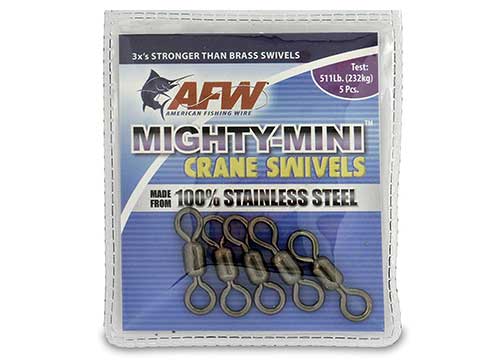
Thes AFW mighty crane swivels in 310-pound strength are good for making chicken rigs. One of these swivels is used to tie the main line to the leader line.
Bottom Rig Weight

For chicken rigs, one ounce to one pound weights are typically used. It depends on the depth of water and the strength of the current. If the current is really strong a 2-pound weight might be needed. If the rockfish are small it might be hard to feel a bite with a two-pound weight on the line.
In the video above I show how to tie the best dropper loop for chicken rigs.
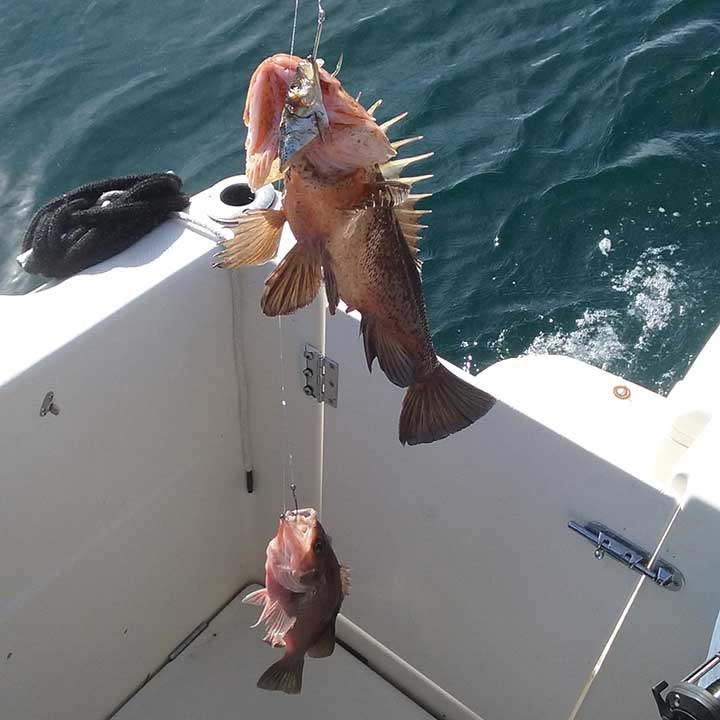
4. Swim Jig With a Teaser
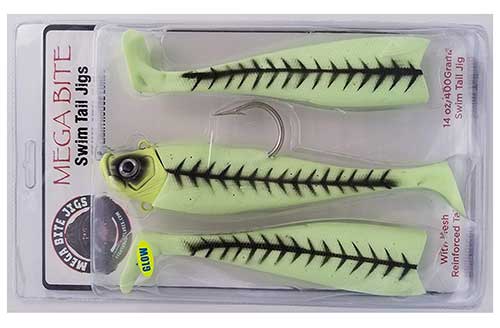
The mega bite jig is 9-inches in length and weighs 14-ounces. This large jig is good for big non-pelagic rockfish. I would recommend placing a teaser hook about 18 inches above the jig. This is done by tying a dropper loop in the line and sliding the loop through the eye of the hook. I show how to do this in the video below. A piece of cut bait should be added to the teaser hook. This adds scent and will probably catch more fish than the jig itself.
Jigs are good to have in the water because the jigging motion attracts fish and keeps them hanging around the other lines as well. These jigs are a bit large for small rockfish but defiantly catch large fish. If you do not need large weights to fight the current a jig with a teaser would be my number one rockfish rig.
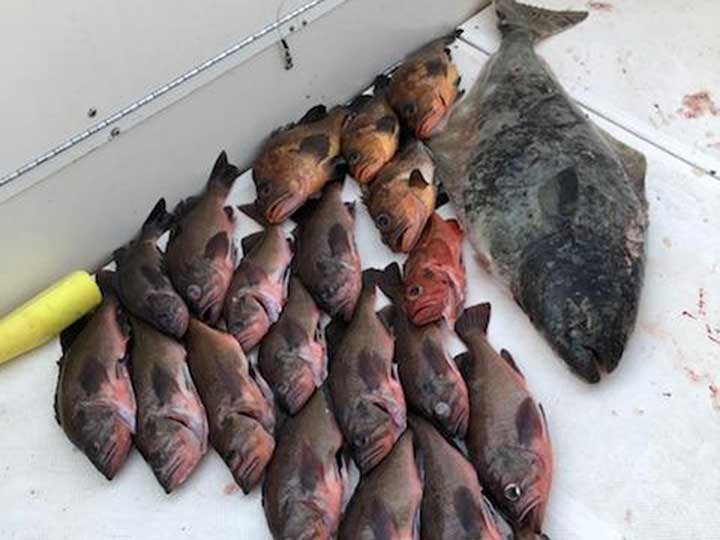
5. Mega Bite Max Rockfish Swim Jig
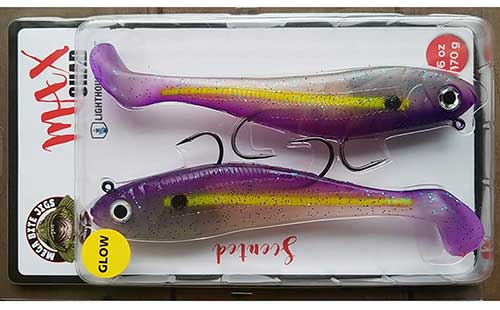
These swim jigs are 8 inches in length and weigh 6 ounces. There are 9 different color patterns. Four of the color patterns are glow in the dark which helps attract fish in deep water. The two hooks on the bait help the bite to catch ratio. These jigs are perfect for catching rockfish in under 100 feet of water.
These jigs look similar to herring a common fish for rockfish to eat. A teaser hook can also be tied above these jigs. Pieces of cut bait such as squid can be placed on the hooks to add scent to the jig. Also, pro-cure herring scent gel can be applied to the outside of the jig to add scent.
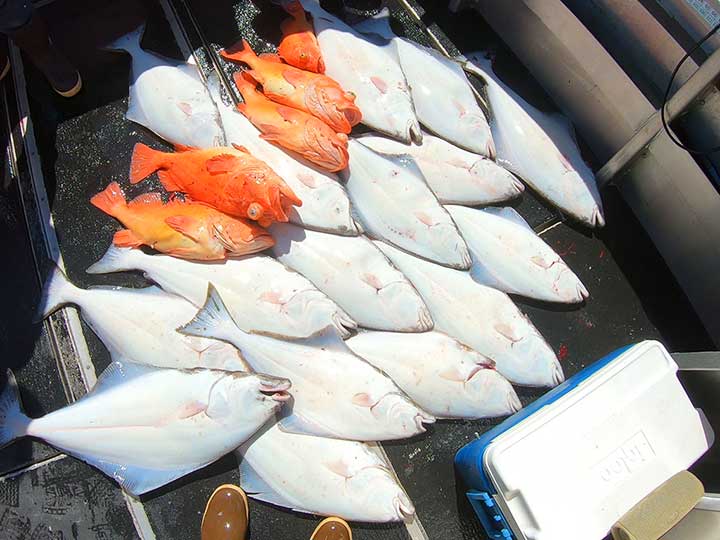
6. Squirrely Shirley White Jig
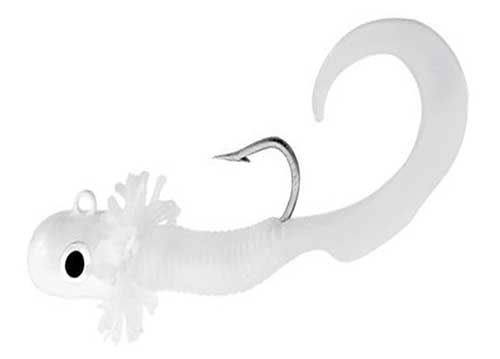
Gibbs Delta 8 ounce jig with a white lead head and a white tail. This is a very popular jig for bottom fishing. This works well to catch rockfish, halibut, and lingcod. Again I would recommend placing a teaser hook with bait about 18-inches above the jig. This jig has a sleek profile and sinks quickly.
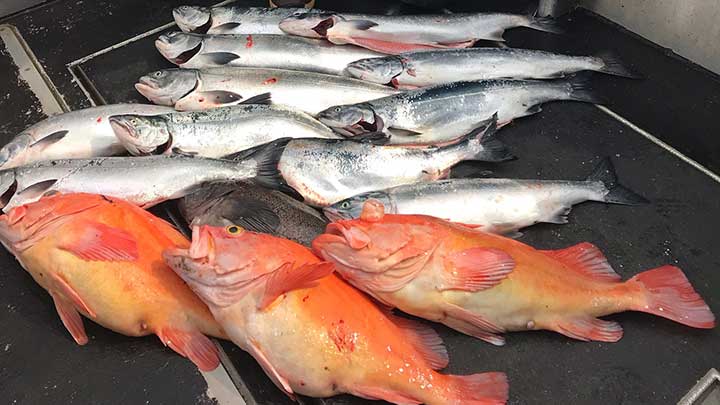
7. Tsunami Swim Rockfish Jig
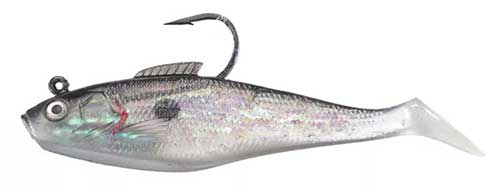
Tsunami swim jigs are a great way to catch rockfish in less than 100 feet of water. Size options for the jigs are 3-inch 3/8 ounce, 4-inch 1 once, 5-inch 1-3/8 ounce, 6-inch 2-3/8 ounce, 6-1/2 inch 4-1/4 ounce, 7-inch 3 ounces, and 9-inch 6-1/4 ounce. All of these are good sizes for rockfish.
Good color options for rockfish are purple haze, pearl spot, mullet black back, and blue back. Tipping the jig with bait or added scent can be helpful but most of the time the jig will work well for rockfish without scent. These can be fished on halibut rods but work better on salmon reels.
8. Tsunami Holographic Rockfish Jig

The Tsunami holographic sand eel jigs are good to use for rockfish around sand flats and gravel flats. Sand lance live in these areas and look very similar to this jig.
It comes in sizes of 6-inch 3/4 ounce, 7-inch 1 ounce, 8-inch 1-1/5 ounce, and 9-inch 2-1/2 ounce. Color options are black-back and olive-back both of which have a reflective green holographic appearance. These jigs can also catch halibut and salmon.
9. Bucktail Rockfish Jig
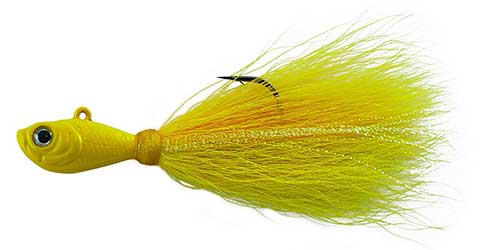
Bucktail Jigs are a widely used jig to catch many types of fish including rockfish. These jigs come in 8 size options ranging from 1/2 ounce to 5.5 ounces. Good color options for rockfish include spearing blue, red-white, chartreuse, blue shad, and sand eel green. The best way to add scent to this jig is with a Gulp curly tail grub.
10. Gulp Grub Curly Tail Rockfish Bait

Gulp Grub is a great curly tail bait to use with Spro bucktail jigs. This bait will also work on a live bait rig or on a teaser above the jig. Good color options for rockfish include white, salmon red, mackerel, and red belly shrimp.
These come in sizes of 5-inch and 6-inch which are good for bucktails over 3 ounces. For smaller bucktails use Gulp Swimming Mullet in the 4-inch size.
11. Hoochie Squid Skirts for Rockfish
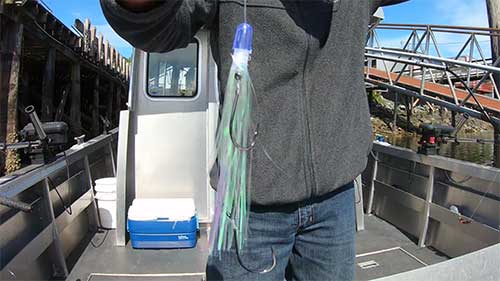
This gold star Mother of Pearl Twinkle Skirt is a must-have beneath all hoochies. Alone is looks like a fly or a sand lace. When added to a hoochie it gives thickness and flash to the bait. The plastic dome at the front also spaces the hoochie further forward on the hook. Otherwise, beads are needed for spacing. I put this on a mooching leader with two snelled hooks. This could also be placed on a single open eye hook using a barrel swivel and bead for spacing.
Goldstar Hoochie For Rockfish
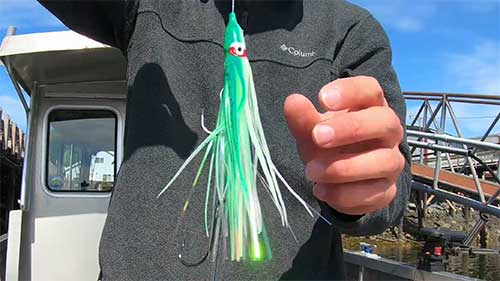
Goldstar green glow hoochie skirts. These 4 1/4 inch squid baits work great to catch both rockfish and salmon. These can be placed on a mooching rig or on the dropper loops on the chicken rig. Rockfish are pretty aggressive and will bait most baits. The advantage of a hoochie over cut bait is that it will not come off the hook. When using live bait after 10 seconds on the bottom you normally catch a fish or have the bait stolen. Having bait and hoochie makes it so you still have bait in the water.
12. Rockfish Ball Jig with a Hoochie
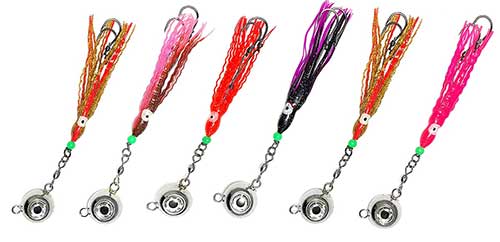
Flue ball jigs are a good way to fish for rockfish. These can be fishing on salmon mooching rod and reels. The jig consists of a chrome weighted head connected to a hoochie with two hooks. Bait can be added to the hooks.
Size options for these jigs are 1-ounce, 2-ounce, 3-ounce, 4-ounce, 5-ounce, and 6-ounce. Each set comes with six jigs in colors of gold-orange, root beer, orange, black-purple, and bright pink. Placing a teaser bait above the jigs is a great way to fish for rockfish and can allow more than one fish to be caught at a time.
13. Octopus Rockfish Bait
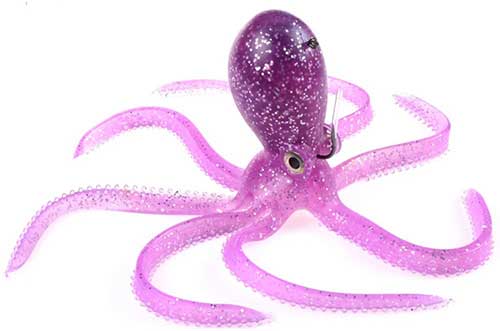
Octopus is a good bait to use for rockfish. These life-like soft octopus jigs come in sizes of .81 ounces, 6.35 ounces, and 9.88 ounces. Color options are white, yellow, purple, orange, brown, and black. The smaller .81 ounce jigs have a j-hook and a treble hook. The larger baits just have a j-hook but have a loop on the bottom of the jig to attach additional hooks. It is recommended to add additional hooks.
14. Rockfish Jig Point Wilson Dart
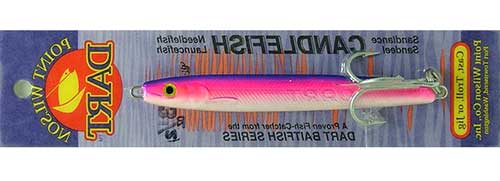
The Point Wilson Dart candlefish jig is a popular verticle jig in the north pacific to catch rockfish, salmon, and halibut. It comes in sizes ranging from 2-1/4 ounces to 6 ounces. Good color options for rockfish include blue-gold, green nickel, and green-yellow. This dart jig sinks fast and the 6-ounce version can fish up to 250 feet deep in most currents. The treble hook works well at hooking rockfish.
Rockfish Release Devices
Rockfish have a swim bladder that does not vent. When reeling fish up from deep depths rockfish suffer from barotrauma. This is when the swim bladder expands and even the eyes of the fish can pop out of their sockets due to the pressure change. The fish is going to die unless it is brought back to depth with a fish descender. There are many fish descender devices.
The state of Alaska requires that all rockfish caught at depth are released with a rockfish release device. People are also encouraged to practice fishing techniques to reduce the number of unwanted rockfish to be caught. This can be done by fishing for other species first. Also when fishing for halibut and lingcod the bait should be kept 10-15 feet off the bottom. It has been shown that less rockfish will be caught and will not affect the catch rates of halibut or lingcod.
Seaqualizer Fish Descender
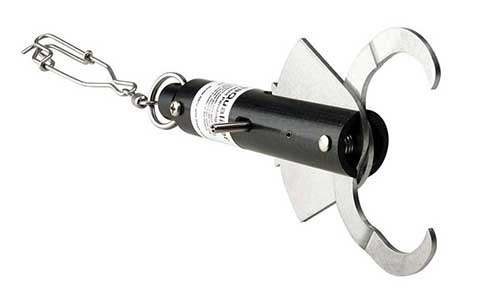
The Seaqualizer works by attaching the fish to the clip, adding weight, and tying the other end to a fishing pole. The fish is sent back to depth and when the fish reaches 100 feet, 200 feet or 300 feet the gripper opens and the fish is released. The depth it opens at varies depending on the selected setting. This is the best way to release fish that are caught in deep water. If the rockfish is large the seaqualizer will need to be clipped to a downrigger weight and descended using the downrigger.
In the video above I show the many different types of rockfish release devices.
Simple Fish Descender

This simple fish descender works well for releasing small rockfish with a one-pound weight. If the rockfish are two large even a three-pound weight will not get them to sink. This is when the Seaqualizer needs to be hooked to the downrigger to descend the rockfish.
Fish Vent Tool
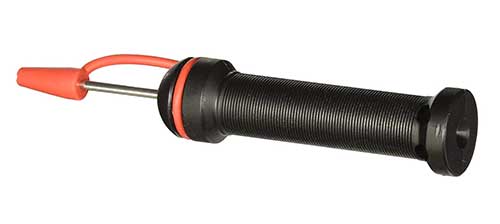
Fish vent tool or needle. Do not use a fish vent tool. It is illegal in the state of Alaska. This works by placing the needle under a scale of the fish to release or vent the air from the swim bladder. The fish should then be able to swim back to depth. Studies have shown that the survival rate is much higher if a fish descender is used to bring the fish back to depth without puncturing the fish with a needle. The main problem with venting a fish is the injury might not heal and the fish will die. Often times the puncture area becomes infected.
Types of Rockfish
Yelloweye Rockfish
Yelloweye rockfish are a common type of rockfish to catch and get up to 3 feet long which would be about a 40-pound fish. Female yelloweye rockfish have over two million eggs and give live birth. This fish is sometimes called a Pacific red snapper but is not the same species of red snapper commonly caught in the Gulf of Mexico. Alaska is the best location to catch Yelloweye rockfish.
Quillback Rockfish
Quillback rockfish are common non-pelagic rockfish to catch and get up to 2 feet long. It has sharp venomous quills on its dorsal fin and also gives live birth.
Dusky Rockfish
Dusky rockfish are a very common fish to catch and get up to 20 inches long which would be about a 10-pound fish. Female dusky rockfish have over 100,000 eggs and give live birth.
Food Quality of Rockfish
Rockfish is one of the best-eating fish in the north pacific. Similar to grouper it is often sold in restaurants. Rockfish do not have a high fillet weight to total fish weight. For comparison halibut get a 65 percent yield, salmon get a 76 percent yield and rockfish get a 49 percent yield. This is comparing the weight of the fish gutted to the filet weight with the skin on. These rates do vary based on the size of the fish.
Black rockfish get the highest yield percentage at 56 percent. Recreational anglers can keep three of these per day in Alaska and black rockfish are often targeted when salmon or halibut fishing is slow. Non-pelagic rockfish have a much lower quota, for example, only one yelloweye rockfish can be caught per angler per year. This is because these fish have a slow growth rate and long life.
How to Catch Rockfish
Rockfish are one of the most common and easiest types of fish to catch in the north pacific. However, there are over 130 types of rockfish and some rockfish are rare to catch. The basic strategy for catching rockfish is to first mark them on the fish finder. When targeting rockfish it is common to fish in less than 100 feet of water.
Using herring is a sure way to catch rockfish. Herring can be used on a mooching rig, halibut rig, chicken rig, or placed on the tip of jigs and lures. When trolling for salmon with downriggers it is common to catch rockfish on hoochies and spoons. Swim jigs and bucktail jigs are good artificial baits to catch rockfish. Yelloweye rockfish are commonly caught when halibut fishing in water deeper than 200 feet. Make sure to have a rockfish release device on the boat to properly send fish caught deep back to depth.
Frequently asked Questions
Is rockfish the same as red snapper?
Yelloweye rockfish are sometimes called the pacific red snapper. In my option, they look more like a bright orange grouper than red snapper from the Gulf of Mexico. Red Snapper and yellow rockfish are two different species and are not the same fish. Another common name mistake is that people on the east coast call striped bass, rockfish. Striped bass look completely different from rockfish.
Is rockfish a healthy fish to eat?
Yes, rockfish is a healthy fish to eat as it is high in protein and omega-3 fatty acids. Rockfish should be consumed in moderation though as it contains moderate levels of mercury. Black rockfish or seabass is the best type of rockfish to eat in my opinion. Rockfish are commonly served in restaurants and are a popular fish to eat.
How much weight is needed when fishing for rockfish?
The amount of weight needed to catch rockfish varies depending on the water depth. In less than 100 feet of water, a 4-6 ounce weight can be typically be used. In strong currents and deep water, 1-2 pounds of weight is needed to get the bait near the bottom where the fish are typically located.
Using heavy weights can make feeling the bite and setting the hook difficult. Using small circle hooks and less weight when possible makes fishing for rockfish easier and more fun, especially when fishing with kids! There are specific limits for each type of rockfish so be prepared to use a fish descender or fish shallower water once a limit is reached to ensure that the released fish survive.
Where do you find rockfish?
Rockfish can be caught from zero feet deep to over 1800 feet deep. Most rockfish are in 20-400 feet of water along rocky bottom structures. There are often found in large schools suspended in the water as well. Pacific rockfish are found from northern Alaska all the way to southern California.
How do you catch vermilion rockfish?
A vermillion rockfish looks very similar to yelloweye rockfish. These are caught with the same baits and jigs as other rockfish. To target this specific type of rockfish anglers will have to find areas with a high population of vermilion rockfish. It is hard to know where this will be though unless you fish lots of different spots and notice a spot that frequently catches this type of rockfish. In Sitka Alaska, I know a good spot with lots of vermillion rockfish in about 100 feet of water.
How old do yelloweye rockfish get?
Different types of rockfish have different lifespans. The types of rockfish that live the longest are the shortraker rockfish which live about 120 years and the rougheye which live around 140 years. The oldest rockfish ever caught was a shortraker that was about 200 years old. Yelloweye rockfish have lifespans up to 121 years old.
How big do rockfish get?
The world record shortraker rockfish was 44 pounds 1-ounce pounds caught in Cross Sound Alaska in 2017. For yelloweye rockfish, the world record is 39 pounds 4 ounces caught in Whalers Cove Alaska.
Captain Cody has worked on charter fishing boats in the Florida Keys, Virgin Islands, and Alaska. Growing up in Pennsylvania Cody has also done extensive freshwater fishing including bass fishing tournaments. Cody strives to provide detailed information about the best fishing gear and tactics to help both novice and experienced anglers have a more productive and enjoyable time on the water. Cody also has a background in aerospace engineering and neuroscience but really only takes pride in being good at one thing and that is fishing!

Where can I buy deep water (14-16 ounce) bucktail jigs. Where to buy feathers and other materials to make bucktail jigs?